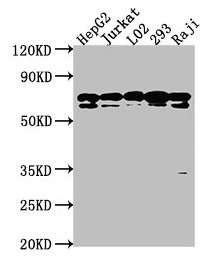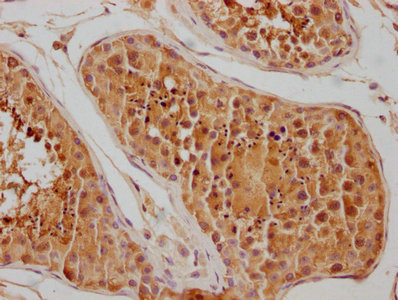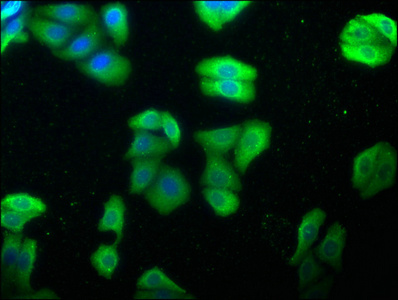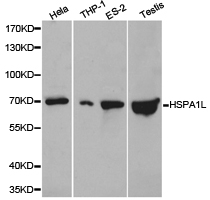
Western Blot Positive WB detected in: HepG2 whole cell lysate, Jurkat whole cell lysate, L02 whole cell lysate, 293 whole cell lysate, Raji whole cell lysate All lanes: HSPA1L antibody at 1:2000 Secondary Goat polyclonal to rabbit IgG at 1/50000 dilution Predicted band size: 71 kDa Observed band size: 71 kDa
HSPA1L Antibody
CSB-PA010823HA01HU
ApplicationsImmunoFluorescence, Western Blot, ELISA, ImmunoHistoChemistry
Product group Antibodies
ReactivityHuman
TargetHSPA1L
Overview
- SupplierCusabio
- Product NameHSPA1L Antibody
- Delivery Days Customer20
- ApplicationsImmunoFluorescence, Western Blot, ELISA, ImmunoHistoChemistry
- CertificationResearch Use Only
- ClonalityPolyclonal
- ConjugateUnconjugated
- Gene ID3305
- Target nameHSPA1L
- Target descriptionheat shock protein family A (Hsp70) member 1 like
- Target synonymsHSP70-1L, HSP70-HOM, HSP70T, hum70t, heat shock 70 kDa protein 1-like, epididymis secretory sperm binding protein, heat shock 10kDa protein 1-like, heat shock 70 kDa protein 1-Hom, heat shock 70 kDa protein 1L, heat shock 70kD protein-like 1, heat shock 70kDa protein 1-like, heat shock protein family A member 1L
- HostRabbit
- IsotypeIgG
- Protein IDP34931
- Protein NameHeat shock 70 kDa protein 1-like
- Scientific DescriptionMolecular chaperone implicated in a wide variety of cellular processes, including protection of the proteome from stress, folding and transport of newly synthesized polypeptides, activation of proteolysis of misfolded proteins and the formation and dissociation of protein complexes. Plays a pivotal role in the protein quality control system, ensuring the correct folding of proteins, the re-folding of misfolded proteins and controlling the targeting of proteins for subsequent degradation. This is achieved through cycles of ATP binding, ATP hydrolysis and ADP release, mediated by co-chaperones. The affinity for polypeptides is regulated by its nucleotide bound state. In the ATP-bound form, it has a low affinity for substrate proteins. However, upon hydrolysis of the ATP to ADP, it undergoes a conformational change that increases its affinity for substrate proteins. It goes through repeated cycles of ATP hydrolysis and nucleotide exchange, which permits cycles of substrate binding and release (PubMed:26865365). Positive regulator of PRKN translocation to damaged mitochondria (PubMed:24270810).
- ReactivityHuman
- Storage Instruction-20°C or -80°C
- UNSPSC41116161






